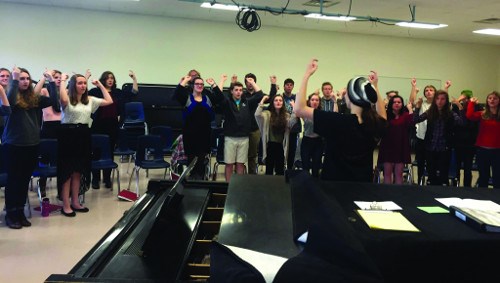Reprinted with permission from the November, 2016 issue of High School Today by the National Federation of State High School Associations.
By Steffen Parker, Williston, Vermont
Music has been used to express a variety of human emotions, allowing the performer to share those feelings with others through the notes, phrases, dynamics – and most often – the lyrics of the piece. Teaching choral music in our schools provides the opportunity for individuals – through solo, small ensemble and large ensemble repertoire – to express themselves in ways that mere words cannot provide.
History is filled with quotes from musicians, poets, writers, historians and politicians on the importance of music, the power of music, the way that music can provide a means to celebrate, to remember, to mourn, to envision and to inspire. And music teachers are continually looking for ways to not only connect their students to the notes on the page, but to help them find the “meaning” in the music, put there a year or a decade or many centuries before by the composer, who chose these notes to express what their words could not.
One choral music educator in northern Vermont came across a method to help his students find the real emotion at the heart of the music being rehearsed and it came in a most unusual manner. While this may not be feasible in all schools, the heart of this effort remains constant throughout – connecting the performer to the music through their heart.
Carl Recchia has been the vocal music educator at Champlain Valley Union High School in Hinesburg, Vermont, for more than 38 years. An accomplished pianist as well, Recchia has involved his multi-level choruses in a wide variety of performance opportunities over the years – producing a 30-minute television performance of Christmas carols to be broadcast at holiday time, collaborations with local adult ensembles in joint concerts, providing music for a professional dance troupe’s presentation at a local theatre – all while supporting and expanding his students’ musical abilities.
This past school year, Recchia was provided an exciting opportunity he had not encountered in his teaching career. A senior student, Molly, who he had known for some time, joined his chorus class for the first time. Molly was already an accomplished actress, videographer, writer and an expert at her native language, American Sign Language (ASL). Molly, who is almost completely deaf, had the good fortune of having not one, but two interpreters – one of whom, Liz, is a trained singer and actress.
 Having Liz on board provided Recchia the opportunity to include Molly in the chorus class and the mixed voice ensemble. Despite losing her hearing at the age of 2, Molly loves to sing, thanks, in part, to her parents who are lifelong music educators.
Having Liz on board provided Recchia the opportunity to include Molly in the chorus class and the mixed voice ensemble. Despite losing her hearing at the age of 2, Molly loves to sing, thanks, in part, to her parents who are lifelong music educators.
Among the many surprises that came from having Molly in chorus was that she can match pitch. Best able to hear and replicate high frequencies, Molly was a strong contributor to the soprano section of the chorus. She was sensitive and always careful to blend and balance with the other singers. Molly learned to translate what she heard through her hearing aid in her one ear and worked hard at being a part of her section.
Molly’s perseverance and kind spirit allowed her to easily make friends, and the chorus members came to respect and admire her for her desire to fit in and be a contributing member of the ensemble. As part of learning the music, Molly and Liz would sign the lyrics and the chorus could see how graceful and elegant ASL can be.
As a result, Recchia asked Molly to teach her chorus how to sign one of the pieces being performed. Other classes heard of this effort and asked to be included and eventually Molly taught the entire chorus how to sign “The Storm is Passing Over,” which was performed at one of the school’s concerts.
The expressive nature of ASL combined with the physical movement required provided the hearing students with another avenue to understand the emotions of the piece and the power of the lyrics, and to portray them in a multi-faceted manner to the audience. Having Molly conduct the group using ASL and standard conducting techniques added to the group’s experience and the power of the music.
Having a deaf person signing and singing with her high school chorus – a chorus willing to learn a new language and incorporate it into their performance – was an enlightening experience for the chorus and allowed the audience to witness the power of music, community and generosity of spirit. ASL allowed the students to understand the music at a deeper, more profound level – one that allowed their hearts to touch others.
“While I know there are choruses for all, I will continue to explore the possibilities of reaching out to, and including, non-traditional singers in my choruses,” Recchia said. “We thank Molly for the many gifts she shared with us and for teaching us how to sign as we sing. Besides, singing and signing are spelled almost the same!”
By incorporating ASL into his group’s performance, Recchia not only provided another student the opportunity to participate in music in her school, but also found a new way to teach his students about the emotion in music so that they could sing it in a manner closer to the composer’s intent. Through ASL and combining singing and signing, a stronger musical presentation was
made possible














